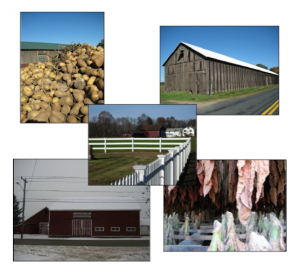Agriculture is at the heart of local history in the Connecticut River Valley. The rich alluvial soil encompassed by this bend in the Connecticut River has sustained families for centuries. From the plants and animals that nourished native communities to the fattened cattle that once left this town for markets in colonial Boston to the asparagus and tobacco that is shipped today around the globe, farm products have been the cornerstone of the local economy for centuries.
The history and beauty of this farmland are recognized by the town of Hadley, and active conservation and agricultural preservation are top priorities. Hadley farmers, town boards and local land trusts have preserved acres of farmland–so much that Hadley boasts the largest amount of preserved farmland (nearly 3000 acres) in the Commonwealth.
The Hadley Historical Commission and the UMass Public History Program have enjoyed a long and fruitful relationship around their shared interest in the preservation of our area’s heritage landscapes. Long interested in sustainability, environmental history, public history and the ways historians intervene responsibly in the preservation of community memory, the Public History program has for over a decade supported the efforts of the Hadley Historical Commission to document historic buildings and landscapes in that community. A series of initiatives surrounding agricultural history have been particularly important, and form the core of this web resource.
In 2003, the Hadley Historical Commission together with the Public History Program and its partners in the UMass department of Landscape Architecture and Regional Planning, with funding from the UMass Public Service Endowment Grant program, undertook a cultural resource study of the Hadley Common and Great Meadow. In 2008, Public History graduate students conducted an inventory of Hadley’s agricultural structures; the results are posted here under the Hadley Barn Survey tab above. Most recently, as the Hadley Historical Commission prepared to celebrate Hadley’s 350th year in 2009, commissioners decided to dedicate its anniversary-year energy and resources to a project documenting the town’s barns. With funds from the Community Preservation Act, we engaged Bonnie Parsons of the Pioneer Valley Planning Commission to survey structures across town. Parsons, together with her colleague Jayne Bernhard-Armington (an alumna of the UMass Public History Program) and University of Massachusetts Amherst graduate student Christopher Benning, a member of the initial barn survey team, set out to gather and interpret oral, archival and physical evidence of Hadley’s agricultural past.
This website is also part of that project, an attempt to share the results of the survey effort, to make available some of the historical materials on which that project was based, to invite users to read other survey materials that the commission has assembled over time, and to promote a broader interest in preservation by posting resources of use to community preservationists.
We will continue to add to this site as new resources are developed. Meanwhile, please send comments or questions to hhc@hadleyma.org.


